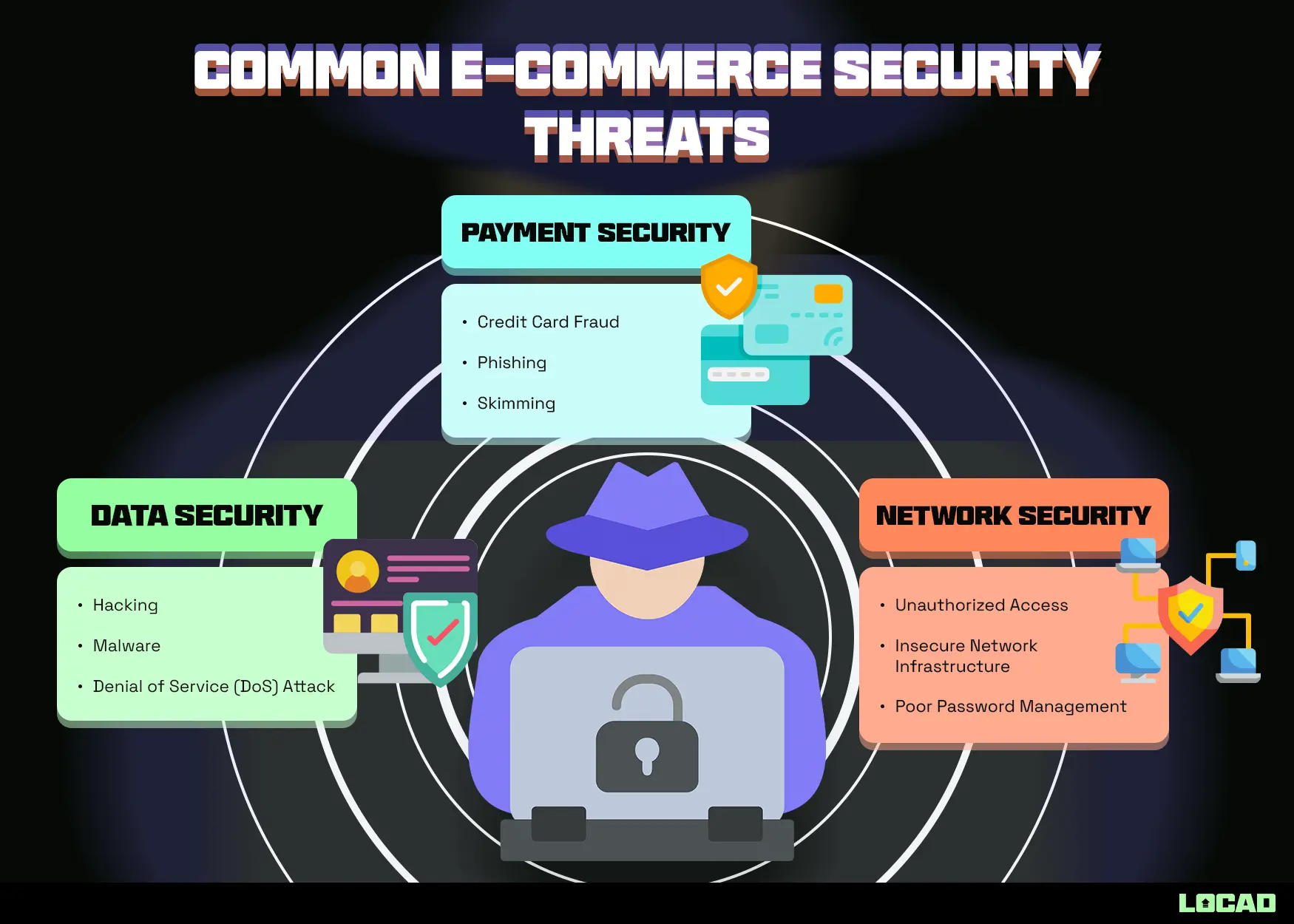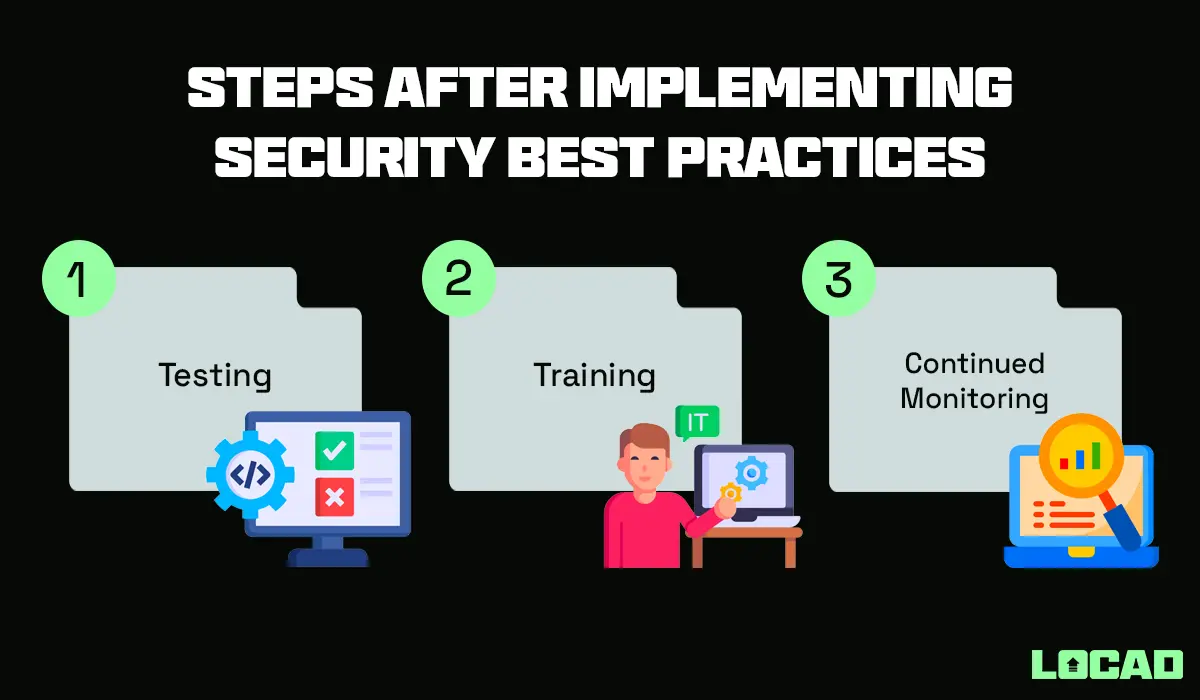Security is essential to any successful e-commerce business in today’s digital world. With the rise of the internet, the number of cyber threats has increased exponentially, increasing the number of fraudulent activities taking place. Without the right security measures, these threats can cause immense damage to businesses, both financially and reputationally.
According to a report from Statista, In 2020, the e-commerce fraud detection and prevention market was over 28 billion U.S. dollars. This figure is estimated to grow steadily in the coming years, reaching over 69 billion U.S. dollars by 2025.
Not only can e-commerce security protect businesses from financial losses, but it can also help protect them from reputational damage. In a data breach, customers’ personal information may be compromised, leading to a loss of trust in the business.
What is E-commerce Security?
E-commerce security safeguards online transactions and digital interactions between customers, businesses, and vendors. E-commerce security is becoming increasingly important as more consumers shop online, making it necessary for businesses to protect their customers’ data while protecting their own e-commerce business from cybercriminals.
With the number of cyberattacks increasing every year, organizations must be diligent in implementing security protocols to maintain the trust of their customers. Cybersecurity measures such as encryption, authentication, and authorization can help protect customer data and company assets from malicious actors.
Authentication is one of the most important aspects of e-commerce security as it requires both buyer and seller to be legitimate and provides proof of identity. Encryption is also a key element as it protects the data transmitted over the network.
Common E-commerce Security Threats
With the growth of e-commerce comes a heightened level of risk regarding data security. Businesses must be aware of the common threats in the digital space and how to best protect their customer data.

Data Security
Data security is one of the most important aspects of e-commerce safety and security. Data security includes protecting customer data from hackers, malware, and denial of service (DoS) attacks.
- Hacking
Hacking is a type of cyberattack that involves gaining unauthorized access to a computer system or network. Hackers can use this access to steal customer data, modify or delete files, or take control of the system. Businesses should take steps to protect their systems from hacks, including implementing strong passwords and two-factor authentication, using a secure connection, and regularly patching software.
- Malware
Malware is software that is intended to harm or disable computer systems. Malware commonly includes viruses, ransomware, and spyware. Businesses should use anti-malware software and scan their systems on a regular basis to protect themselves from malware.
- Denial of Service (DoS) Attacks
DoS attacks are a type of cyberattack that seeks to make a computer system or network unavailable for use by flooding it with traffic or requests. DoS attacks can cause significant disruptions to an e-commerce store, including slowing down or crashing the website, preventing customers from accessing the site, and preventing orders from processing.
Payment Security
Payment security is critical for any e-commerce business, as customers trust their sensitive financial information to your website. Payment security threats come in many forms, including phishing, skimming, and credit card fraud.
- Credit Card Fraud
Credit card fraud is one of the most common forms of payment security threat. Credit card fraudsters use stolen credit card numbers to make unauthorized purchases. It’s important to ensure your website is PCI-compliant to prevent credit card fraud. This will include using SSL encryption, tokenization, and other security measures.
- Phishing
Phishing is a common tactic cybercriminals use to access sensitive information. Phishing involves sending out emails that appear from a legitimate source but are malicious. The emails often contain a malicious link or attachment that installs malware onto the user’s computer.
- Skimming
Skimming is another payment security threat when a malicious actor places a device on a payment terminal or ATM to capture credit card information. Skimmers are becoming increasingly sophisticated; some can even be used remotely via Bluetooth. To protect against skimming, it’s important to ensure that any payment terminals and ATMs have up-to-date security protocols.
Network Security
Network security is one of the most essential parts of any e-commerce security strategy. It’s important to ensure that your network is up-to-date with the latest security protocols and that you’re using a secure network architecture. It’s also important to regularly monitor your network to ensure its security. This can be done through network scanning and intrusion detection systems.
- Unauthorized Access
Unauthorized access is a major security threat in the e-commerce world. This can be done through malicious software, phishing attacks, and other malicious activities. It’s important to ensure that all of your systems are secured and that you’re using strong authentication methods to prevent unauthorized access.
- Insecure Network Infrastructure
Insecure network infrastructure is another common security threat. It’s important to make sure that your network is regularly updated and maintained in order to prevent any cyber-attacks. Additionally, you should make sure that your network is protected from the inside out, with firewalls, VPNs, and other security measures. A proxy extension can also help enhance security by masking your IP address and encrypting your online traffic, providing an extra layer of protection against external threats while ensuring secure communication within the network.
- Poor Password Management
Poor password management is another common security threat in e-commerce. It’s crucial to ensure that all of your passwords are strong and that they’re regularly changed. Additionally, you should also ensure that all of your staff members have unique passwords and that they’re not shared with anyone else.
Best Practices for Protecting Your Customers and Business
Security is a vital component of an online business. Hence, we have discussed in detail some of the ways to curb any security breaches or reduce their chance of occurrence. Read ahead to know more about how you can protect your business and your customers.
- Establish security policies
It’s important to establish clear security policies for your e-commerce business to protect your customers and business. This includes ensuring that your staff understands the company’s security policies and that all customer data is kept securely.
You can also ensure that all customer transactions are encrypted to protect sensitive information from potential hackers. Additionally, you should be aware of any legal or regulatory requirements that might apply to your e-commerce website and comply with them accordingly.
- Implement secure payment methods
Now that we have established the importance of e-commerce security and gone over some common threats, it is time to discuss best practices for protecting your customers and business. Implementing secure payment methods is one of the most important things when running an online store.
You must ensure your web pages are secure and have an SSL certificate. You should also avoid storing cardholder data if not required and use a combination of encryption technology and secure server technology like HTTPS. Additionally, it is important to suggest strong passwords and pair CAPTCHA with hosted payment forms.
What You Need to Know About E-commerce Website Redesign
What is an E-commerce Website Redesign? For any e-commerce seller, their website is their true identity. Therefore, upgrading an e-commerce website…
- Protect customer data
To protect customer data, it’s important to only collect the necessary information. This means understanding GDPR and CCPA requirements and what data your business needs. Encrypting Personally Identifiable Information (PII) is essential for securing customers’ data.
Furthermore, it’s important to use SSL and HTTPS security to encrypt traffic and keep customer financial data safe. Lastly, using secure e-commerce platforms with the most up-to-date security practices is key for keeping customers’ data safe and secure.
- Use secure server technology
One of the best practices for achieving this is to use secure server technology. This technology ensures that data sent over the internet is encrypted, making it harder for hackers to access sensitive information such as customer credit card details or passwords.
Additionally, secure server technology enables businesses to authenticate users, which helps protect against unauthorized access. By implementing secure server technology, businesses can ensure that their customer’s data is kept safe and secure, giving them peace of mind when shopping online.
- Implement strong authentication
Having established security policies and implemented secure payment methods, we must now consider how best to protect customer data. One of the most effective ways to do this is by implementing strong authentication. This involves requiring customers to provide additional information or verification to access their accounts or complete transactions.
Two-factor authentication is a popular example of strong authentication, as it requires the user to enter a one-time code sent via email or SMS before they can log in. By utilizing strong authentication, businesses can ensure that only authorized users can access sensitive data and reduce the risk of fraudulent activities.
- Regularly update software
It is essential to regularly update software and applications to protect your e-commerce website from cyber threats. It’s important to stay on top of any new patches or updates released for software and applications, as these may contain security fixes that can help protect your website.
Additionally, monitoring your website’s IP address and domain name for suspicious activity is important. If you suspect any malicious activity, immediately protect your customers and business. By taking these measures, you can ensure that your e-commerce website remains secure and protected from possible e-commerce threats and solutions.
E-commerce Customer Service Tools
As commerce continues to shift online, the importance of exceptional customer service for e-commerce businesses cannot be overstated. With fierce…
- Employ cyber security measures
One of the best things you can do is employ cyber security measures. This includes investing in secure server technology, such as firewalls and antivirus software, and training your team on best cybersecurity practices.
Several cyber security tools are available to help e-commerce businesses secure their digital platforms and protect customer data. These measures include firewalls, malware scans, and antivirus software.
Companies can offer secure payment methods such as PayPal or Apple Pay, which provide an extra layer of encryption for transactions made on their websites. By taking these steps, businesses can ensure that customer information is secure from unauthorized access by hackers or other malicious actors.
- Using Secure e-commerce or Website Hosting
Secure e-commerce or website hosting can provide an extra layer of protection for customers’ data and sensitive information, helping to keep them safe from malicious actors. Implementing a secure e-commerce solution on your website is essential to protect your customer and business data from hackers.
A secure e-commerce hosting provider can provide enhanced protection against external threats such as distributed denial-of-service (DDoS) attacks, spam, viruses, phishing attempts, and malicious code injections. So, make sure to choose your hosting provider carefully, and in case you’re not satisfied with yours, use WordPress multisite migration to easily migrate your website to a new one if necessary.
The provider should also be able to integrate brand safety tools like ESP (email service providers) and cold email software into their platform so that the retailer’s emails are sent securely to its customers without any risk of being intercepted by cybercriminals.
- Using Secure Network Management
As businesses increasingly rely on digital networks to facilitate transactions and store sensitive data, they must implement secure network management practices to protect their customers’ information. By investing in secure network management software, businesses can ensure that their networks are regularly monitored for malicious activity and unauthorized access attempts.
Email software plays an important role in these efforts. Businesses can use email software to detect suspicious emails and potentially malicious attachments before they reach users’ inboxes. Email filtering can also be configured to block out spam or unwanted messages from reaching users altogether, reducing the risk of employees accidentally downloading malware or clicking on malicious links within emails.
- Implement secure data storage and backup solutions
Secure data storage and backup solutions are essential to any company’s IT security plan to protect customer information from malicious actors. Fortunately, businesses can use several tactics to ensure their data is secure and backed up properly.
One way to securely store customer data is to encrypt the information so it cannot be accessed or understood without an encryption key. Additionally, businesses should use secure hosting services such as cloud computing platforms or virtual private networks (VPNs) that offer strong firewalls and other protections against cyber attackers. Companies should also maintain regular data backups in case of a breach or natural disaster. Data security is essential to any modern e-commerce strategy. One way to ensure your data remains protected is by securing data in the cloud. Cloud solutions offer encryption, robust access controls, and regular security audits which can prevent unauthorized access and mitigate risks associated with digital threats.
Experience fulfillment by Locad today!
After Implementation
With the proliferation of cyber threats, companies must ensure that their online stores are adequately protected from malicious actors. Implementing an e-commerce security plan is a comprehensive process that involves testing, corporate cyber security training, and ongoing monitoring.

- Testing: Testing is the first step in ensuring an e-commerce website is secure and properly functioning. This includes testing for vulnerabilities like SQL injection, Cross-Site Scripting (XSS), and Cross-site Request Forgery (CSRF). It is important to test for these vulnerabilities to identify and fix any weaknesses that malicious actors could exploit. A thorough testing process should also include a review of the website’s coding, assessing the security of login pages, analyzing the system’s data encryption, and establishing a secure connection to the payment processor.
- Training: To ensure that an e-commerce website is secure and functioning properly, it is also important to provide training to the staff, both technical and non-technical. This training should include secure coding practices, data handling, authentication and authorization, and security protocols.
- Continued Monitoring: Finally, it is essential to establish a system of ongoing Monitoring to ensure that the e-commerce website remains secure. This includes monitoring potential security threats, such as attacks targeting the website or malicious software, and monitoring the website’s and its components’ performance. Additionally, it is important to track system logs for any suspicious activity and regularly scan for malware.
Conclusion
E-commerce security is an important part of protecting your customers and business from the cyber threats of e-commerce. Implementing the best practices outlined in this article is an essential step to ensuring the safety of your customers and business.
Implementing strong passwords, secure payment methods, and regular software updates are key to ensuring your customers’ data is safe. Additionally, utilizing encryption technology, implementing authentication strategies, and investing in cyber security measures can help protect your business from malicious cyber threats.
In addition, if you wish for logistics safety, it is often a wise choice to invest in a 3PL provider. A service like Locad can be just what you need to ensure that not only is your customer’s data protected but so is their order!

About the author
Sarah Marksons is a Marketing consultant primarily in B2B lead generation. She’s best known for her insightful blogs on email marketing, B2B and SaaS companies, and business growth. Sarah also has a good network in the sales industry, especially in the digital sales community. Apart from her work, she contributes to the community as an animal rights advocate. She loves creative writing, aspiring to make the world safer for everyone through marketing, writing, and everything she does.
What should I do if a security breach occurs?
Act quickly by isolating affected systems, notifying customers about the breach, working with cybersecurity professionals to investigate and mitigate the breach, and enhancing security measures to prevent future incidents.
How can I build trust with my customers regarding e-commerce security?
Display trust indicators like SSL certificates, privacy policies, and security seals. Communicate your security measures clearly, provide transparent customer support, and promptly address any security concerns or incidents.
How can I ensure the security of my supply chain?
Vet and establish relationships with trustworthy suppliers, implement secure communication channels, conduct regular audits of suppliers’ security practices, and maintain transparency and oversight throughout the supply chain.
How can I prevent unauthorized access to my e-commerce website?
Implement strong password policies, enable secure authentication methods like CAPTCHA, utilize firewalls and intrusion detection systems, and regularly update your website’s CMS, plugins, and themes to patch security vulnerabilities.











